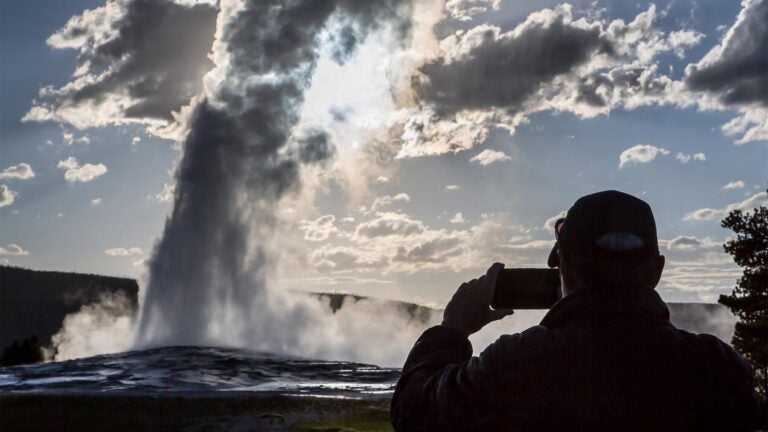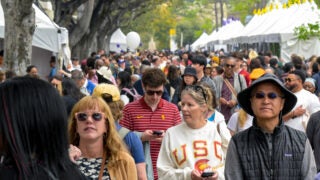
A visitor photographs Old Faithful at sunset. (Photo/Courtesy of Yellowstone National Park)
A guide to U.S. national parks — courtesy of 30+ USC professors
Douglas Noble knows people from all walks of life appreciate the beauty of the 63 U.S. national parks. He’s bringing that mindset to students at USC — with help from a few dozen colleagues.
Douglas Noble loves national parks, and he knows he’s not alone. People from all walks of life and academic backgrounds can appreciate the beauty of the 63 U.S. national parks, and Noble — an associate professor of architecture — wanted to capture that in a course at USC.
Now, after years of pitching and gauging interest, Noble will share his love of the parks with students from all majors — and he’s getting help from dozens of his colleagues from across the university.
“A course like this is very unique and only possible at a major university like USC,” said Noble, associate dean for academic affairs at the USC School of Architecture. “One big idea is to show USC students that interdisciplinary thinking and research can be brought to topics from a wide variety of viewpoints. There are a lot of USC faculty members who care about and conduct research related to national parks.”
“An Exploration of America’s National Parks” will be offered to all students for the spring 2022 semester. The overall theme of the course is how humans interact with the national parks, which is why Noble wanted to have lecturers and students come at this one topic through their respective disciplines.
A course like this is very unique and only possible at a major university like USC.
Douglas Noble
Architecture students might look at how park shelters can be more sustainable. Art students might look at all the works that have been inspired by the national parks. Law students might look at how our government protects these lands. Those different viewpoints are what Noble hopes will give students a truly interdisciplinary experience.
Speakers range from across the university and beyond, including the National Park Service. The class will even feature a lecture from USC President Carol L. Folt, who will lean on her own expertise in environmental biology to talk about aquatic environments in national parks.
“With well over 30 different faculty members coming from all these different viewpoints, every day should be exciting,” Noble said.
Starting a national parks course at USC has been architecture professor’s dream
Getting this course to this point has been a true labor of love for Noble. After applying for funding for the past several years, Noble decided to pitch the course through the School of Architecture — a hard sell, as the course is not architecture-focused. Eventually, Noble and fellow architecture professor Karen Kensek were able to convince the school to offer the course.
“First off, the national parks are just cool. They’re America’s gift to itself,” Kensek said. “We’re starting to do [interdisciplinary courses] much more, but there have been years when that wasn’t the case. I’m really hoping we move towards this because I think it’s a great benefit for the students.”
Since the course is interdisciplinary, there are no prerequisites. It’s a four-unit course that consists of seven modules, each of which lasts two weeks long and features five to eight speakers. Noble said the course will not cover all U.S. national parks, though none will be excluded if students or lecturers have a specific park in mind. Though it’s currently an “experimental course,” Noble will look to create a permanent course number if students show up and like it.
“I’d love to see students that would like to sort of carve out a custom interdisciplinary major,” Noble said. “I’d also eventually like to see a national parks institute at USC, with faculty members from across the university coming together — a research institute, but it belongs to everybody interested in the topic.”
For Kensek, the goal is also a little simpler.
“That [students] are inspired to go visit a national park,” she said. “Then, when they’re out in nature experiencing the parks, they’re a little more informed.”



